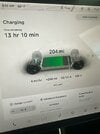Good; and that explains that. At the big disaster mentioned above, which took down Wall Street for some time, there was gear drawing substantial load at 35V or so and some equipment still trying to run at 25V. On a 48V battery plant.Lead acid batteries is very sensitive.
They start to degrade when discharged to 50%, just like the LV 12V lead acid batteries used earlier in teslas.
They sulfate from low SOC, and should not be discharged below 50%, and preferably they are held at 100% all the time.
Its a completely other battery with very few common things to lithium ion
Yeah: 2' in diameter, glass walls, 5' high is one of those; and the plants I've been in had those stacked double high, then rows and rows of them, filling up a good-sized room. With another good-sized room Somewhere Else with the always-on Standby plant. The bus bars were copper, something like 6" square, and we're talking thousands of amperes. Fun. One does not drop a wrench across said bus bars.
The original PUB (it's been madly modified over the years) called for equipment to go to zero load at 39+-1V going down, and coming back to life at 42.5V+-0.5 coming back up. One of my fun jobs over the decades was testing just that.
What's even more fun is making sure that the multi-shelf system software itself can recover from these events. Not a whole lot of fun when some subsidiary electronics goes down due to power loss like this and the upstream control software thinks that it's a permanent fault. You guys don't want to know the number of times I've had to take a group of newbie CS majors and explain the Facts of Life to them. ("But.. but.. computers are always on, right?" "Um. See these GPIO pins right here? The ones that have a pull-up on them? When it's Zero, it's good, but when it's One it means, POWER_FAULT?" "But.. computers are always on, right?" Sigh.)
(In their defense, the time constants for a POWER_FAULT might be measured in the 50's of milliseconds, which is Forever to a CPU that's chugging along at 10ns per instruction or something. So it's kind of critical when a fuse blows to try and get that POWER_FAULT signal out there before VCC decays to the point where the remote equipment isn't working. Ulcers.)
Last edited:



